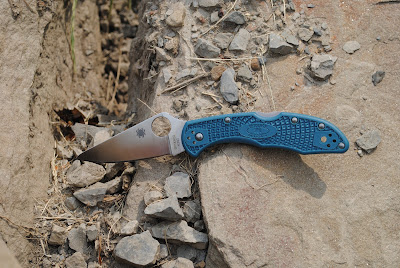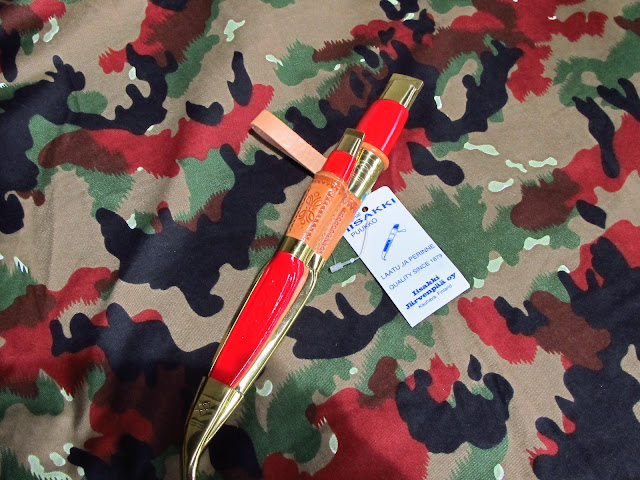Back before it started, the old gods came together for a
meal and to brag about what they contributed the newly forming reality. Loki/the Coyote/the Trickster was especially
gleeful.
“I gave them iron and carbon.”
“So?”
“They mix to form an alloy.
Too little carbon and the steel formed will be soft and useless. Too much and it becomes brittle cast
iron. If they add the just right amount
they get properties all over the place.
And it still rust!”
The old gods thought it was a clever joke on the
humans. All but one, Vulcan/Brokkr/the
Master Forger. Without steel, how could
they build things, he wondered. He crept
off and threw a hand full of elements, and perhaps more important, undiscovered
knowledge into the mix.
Thanks, Vulcan!
 |
| Delica in the key of K390 |
I just got Spyderco’s K390 Delica and it is quickly becoming
my favorite pocket knife. I really like
the Delica/Endura line. Back in day, I
used to fly with two Delicas and airlines had no problem with that. Even back then those sealed packages of
peanuts were hard to open!
 |
| I found I could always depend on Delicas and the K390 is no exception! |
I’m not really a super steel fan. Almost every steel the national brands use is
hardened and tempered to bring you good performance. But right now, for a working knife, I suggest
you look at K390 steel.
K390 is a tool steel with interesting properties. Right now, Spyderco is one of the few
companies making knife blades with it.
Chemical analysis would find:
Carbon:
2.47% (Wow!),
Chromium:
4.2%,
Molybdenum:
3.8%,
Vanadium:
9%,
Tungsten:
1%,
and
Cobalt:
2%.
The rest
is iron.
 |
| It isn't a gamble with Spyderco's four position clip |
Each of these elements affect the basic crystalline
structure of the steel and its properties.
The metallurgy is more complicated than you can imagine. In its simplest form, chromium and vanadium
form small hard carbides that contribute to edge properties. The remaining elements alter the
metallurgical properties.
It doesn’t take a lot of study to realize K390 isn’t a
stainless steel. It is a hard-working
tool steel. And no, you just can’t add another
8-9 %of chromium and make it stainless.
Well, at least if you want to retain the other properties, most of which
go unnoticed by the user. Science tells
us why, but that’s just an understand of how the universe work. For the real reason you’ll have to ask the
Trickster.
 |
| I like the coarse jimping on the FRN handle |
K390 was submitted for an Austrian patented by Bohler in
2002. Bohler wanted a steel to compete
with Crucible’s CPM-10V. It is not a new
steel and gradually found a place among knife makers.
Like all steel, the properties have a give and take aspect
and are affected by heat treatment. K390
is one of the top tier steels with excellent toughness and slicing edge
retention. That is the take. The give is corrosion resistance. You need to take care of your steel, wipe it
dry and use a good oil. Spyderco incudes
a little handout on caring for the steel.
I’d read it if I was you.
 |
| Heading out for Deer camp? Make sure you take a Spyderco Delica in K390. |
Which oil? There are
really two options, food safe and non-food safe. I tend to lean toward food safe, but I’ve
used penetrating oils too.
I like my new Delica with K390 steel. Currently all of Spyderco’s K390 steel come
with a unique blue handle. Mike Janich
tells me he calls it K390 Blue.
The Delica has a flat grind, which contributes to it’s
cutting powers. Not having shoulders,
like the saber grind or it’s brother, Scandi, it doesn’t have to push material
out of the way to keep cutting.
 |
| I don't always go off the beaten path... But when I do it's with a Delica in K390 steel |
The grips are FRN or fiber reinforced nylon. The fibers, to the best of my knowledge are
short glass fibers which strengths the nylon.
The grip sports bidirectional texturing which radiates outward from the
center of the handle. The texturing is
strikingly attractive and more importantly, provides increase purchase with wet
and slippery hands.
The blade has the trademark Spyderco hole. I don’t know which is more uniquely Spyderco,
the fat tick-like spider logo or the functional opening hole. In either case, the thumb hole was genius!
One of the major improvements in the knife world is movable
clips. Sal Glesser, Spyderco founder, is
credited with the pocket clip he called "Clip-it." Later versions of Delica and Endura had a
reversible clip. Eventually most
Spyderco folders have four-position clips.
I simple love that options. Most
of my knives are carried tip up right hand, but I’ve been known to set up a
knife for tip up left-hand carry. While
this may seem trivial to you, this allows Spyderco to be essentially an
ambidextrous knife. Its estimated 10% of
the world’s population is left-handed.
Being able to operate a pocket knife with either your left or right hand
is amazing. Unfortunately, many companies have not caught on to this pocket knife innovation.
 |
| For me the ability to make a fire by shaving fir sticks and scrapping Birch bark in the touch stone to all knives. Spyderco Delica have never let me down. |
Spyderco’s K390
Delica cuts. I cut seatbelt
material. No problem. Opened packages and bags, cut string and
rope. I shaved feather sticks to build a
fire, my personal touchstone of knife performance. Carboard trembles in its presence. What a knife!
The suggest retail price is $176. Right now, all I’m finding on Spyderco
website is the full serration:
https://www.spyderco.com/catalog/details/C11FK390/1885
I suspect if you look about, you’ll find the plain edge on
line.

















